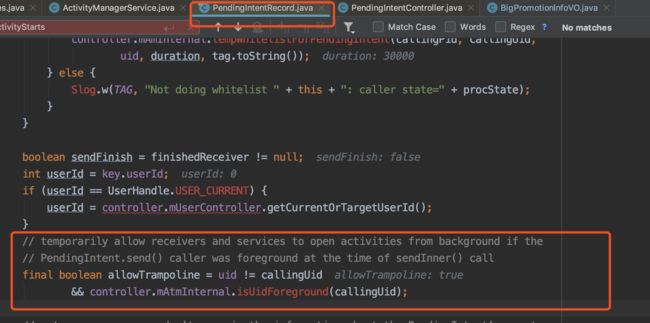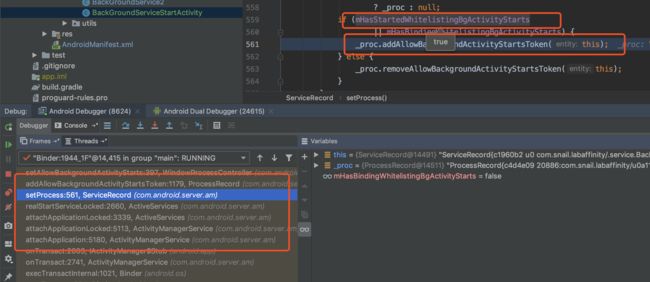Android 后台限制启动Service、Activity与Notification、PendingIntent浅析
Android O之后,很多后台启动的行为都开始受限,比如O的时候,不能后台启动Service,而在Android10之后,连Activity也加到了后台限制中。在Android O 后台startService限制简析中,层分析Android O之后,后台限制启动Service的场景,一般而言,APP退到后台(比如按Home键),1分钟之后变为后台APP,虽然进程存活,但是已经不能通过startService启动服务,但是发送通知并不受限制,可以通过通知启动Service,这个时候,Service不会被当做后台启动,同样通过通知栏打开Activity也不受限制? 为什么,直观来讲,通知已经属于用户感知的交互,本就不应该算到后台启动。本文先发对比之前的Android O 后台startService限制简析,分析下Service,之后再看Activity在Android10中的限制
本文基于android10-release
通知借助PendingIntent启动Service
可以模拟这样一个场景,发送一个通知,然后将APP杀死,之后在通知栏通过PendingIntent启动Service,看看是否会出现禁止后台启动Service的场景。
void notify() {
NotificationCompat.Builder builder = new NotificationCompat.Builder(this, NOTIFICATION_CHANNEL_ID);
builder.setContentIntent(PendingIntent.getService(this, (int) System.currentTimeMillis(),
new Intent(this,
BackGroundService.class),
PendingIntent.FLAG_UPDATE_CURRENT))
.setContentText("content")...)
NotificationManager nm = (NotificationManager) getSystemService(Context.NOTIFICATION_SERVICE);
if (Build.VERSION.SDK_INT >= Build.VERSION_CODES.O) {
NotificationChannel channel = new NotificationChannel(NOTIFICATION_CHANNEL_ID,
"Channel human readable title",
NotificationManager.IMPORTANCE_DEFAULT);
if (nm != null) {
nm.createNotificationChannel(channel);
}
}
nm.notify(1, builder.build());
}
实际结果是:点击通知后Service正常启动。下面逐步分析下。
同普通的Intent启动Service不同,这里的通知通过PendingIntent启动,是不是只要PendingIntent就足够了呢,并不是(后面分析)。通过通知启动Service的第一步是通过PendingIntent.getService获得一个用于启动特定Service的PendingIntent:
public static PendingIntent getService(Context context, int requestCode,
@NonNull Intent intent, @Flags int flags) {
return buildServicePendingIntent(context, requestCode, intent, flags,
ActivityManager.INTENT_SENDER_SERVICE);
}
private static PendingIntent buildServicePendingIntent(Context context, int requestCode,
Intent intent, int flags, int serviceKind) {
String packageName = context.getPackageName();
String resolvedType = intent != null ? intent.resolveTypeIfNeeded(
context.getContentResolver()) : null;
try {
intent.prepareToLeaveProcess(context);
IIntentSender target =
ActivityManager.getService().getIntentSender(
serviceKind, packageName,
null, null, requestCode, new Intent[] { intent },
resolvedType != null ? new String[] { resolvedType } : null,
flags, null, context.getUserId());
return target != null ? new PendingIntent(target) : null;
} catch (RemoteException e) {
throw e.rethrowFromSystemServer();
}
}
IIntentSender在APP端其实是一个Binder代理,这里是典型的Binder双向通信模型,AMS端会为APP构建一个PendingIntentRecord extends IIntentSender.Stub实体, PendingIntentRecord可以看做PendingIntent在AMS端的记录,最终形成两者对应的双向通信通道。之后通知就会通过nm.notify显示在通知栏,这一步先略过,先看最后一步,通过点击通知启动Service,通知点击这不细看,只要明白最后调用的是PendingIntent的sendAndReturnResult函数,
public int sendAndReturnResult(Context context, int code, @Nullable Intent intent,
@Nullable OnFinished onFinished, @Nullable Handler handler,
@Nullable String requiredPermission, @Nullable Bundle options)
throws CanceledException {
try {
String resolvedType = intent != null ?
intent.resolveTypeIfNeeded(context.getContentResolver())
: null;
return ActivityManager.getService().sendIntentSender(
mTarget, mWhitelistToken, code, intent, resolvedType,
onFinished != null
? new FinishedDispatcher(this, onFinished, handler)
: null,
requiredPermission, options);
} catch (RemoteException e) {
throw new CanceledException(e);
}
}
通过Binder最终到AMS端,查找到对应的PendingIntentRecord,进入其sendInner函数,前文buildIntent的时候,用的是 ActivityManager.INTENT_SENDER_SERVICE,进入对应分支:
public int sendInner(int code, Intent intent, String resolvedType, IBinder whitelistToken,
IIntentReceiver finishedReceiver, String requiredPermission, IBinder resultTo,
String resultWho, int requestCode, int flagsMask, int flagsValues, Bundle options) {
if (whitelistDuration != null) {
duration = whitelistDuration.get(whitelistToken);
}
int res = START_SUCCESS;
try {
if (duration != null) {
int procState = controller.mAmInternal.getUidProcessState(callingUid);
if (!ActivityManager.isProcStateBackground(procState)) {
...
controller.mAmInternal.tempWhitelistForPendingIntent(callingPid, callingUid,
uid, duration, tag.toString());
} else {
}
}
...
case ActivityManager.INTENT_SENDER_SERVICE:
case ActivityManager.INTENT_SENDER_FOREGROUND_SERVICE:
try {
controller.mAmInternal.startServiceInPackage(uid, finalIntent, resolvedType,
key.type == ActivityManager.INTENT_SENDER_FOREGROUND_SERVICE,
key.packageName, userId,
mAllowBgActivityStartsForServiceSender.contains(whitelistToken)
|| allowTrampoline);
} catch (RuntimeException e) { ...
其实最后进入controller.mAmInternal.startServiceInPackage,最后流到AMS的startServiceInPackage,接下来的流程在Android O 后台startService限制简析分析过,包括后台限制的检测,不过这里有一点是前文没分析的,
int appServicesRestrictedInBackgroundLocked(int uid, String packageName, int packageTargetSdk) {
...
// Is this app on the battery whitelist?
if (isOnDeviceIdleWhitelistLocked(uid, /*allowExceptIdleToo=*/ false)) {
return ActivityManager.APP_START_MODE_NORMAL;
}
// None of the service-policy criteria apply, so we apply the common criteria
return appRestrictedInBackgroundLocked(uid, packageName, packageTargetSdk);
}
*/
boolean isOnDeviceIdleWhitelistLocked(int uid, boolean allowExceptIdleToo) {
final int appId = UserHandle.getAppId(uid);
final int[] whitelist = allowExceptIdleToo
? mDeviceIdleExceptIdleWhitelist
: mDeviceIdleWhitelist;
return Arrays.binarySearch(whitelist, appId) >= 0
|| Arrays.binarySearch(mDeviceIdleTempWhitelist, appId) >= 0
|| mPendingTempWhitelist.indexOfKey(uid) >= 0;
}
**那就是mPendingTempWhitelist白名单 **,这个是通知启动Service不受限制的关键。
前文说过,通知发送时会设定一个临时白名单的有效存活时间,只有设置了,才能进mPendingTempWhitelist,这是存活时间是从点击到真正start中间所能存活的时间,如果在此间还未启动,则判断启动无效。有效存活时间是什么时候设置的,是发送通知的时候,而且,这个时机只在发送通知的时候,其他没入口:
/Users/XXX/server/notification/NotificationManagerService.java:
void enqueueNotificationInternal(final String pkg, final String opPkg, final int callingUid,
final int callingPid, final String tag, final int id, final Notification notification,
int incomingUserId) {
...
// Whitelist pending intents.
if (notification.allPendingIntents != null) {
final int intentCount = notification.allPendingIntents.size();
if (intentCount > 0) {
final ActivityManagerInternal am = LocalServices
.getService(ActivityManagerInternal.class);
final long duration = LocalServices.getService(
DeviceIdleController.LocalService.class).getNotificationWhitelistDuration();
for (int i = 0; i < intentCount; i++) {
PendingIntent pendingIntent = notification.allPendingIntents.valueAt(i);
if (pendingIntent != null) {
am.setPendingIntentWhitelistDuration(pendingIntent.getTarget(),
WHITELIST_TOKEN, duration);
}
}
}
}
setPendingIntentWhitelistDuration会更新PendingIntentRecord的whitelistDuration列表,这个列表标识着这个
public void setPendingIntentWhitelistDuration(IIntentSender target, IBinder whitelistToken,
long duration) {
synchronized (ActivityManagerService.this) {
((PendingIntentRecord) target).setWhitelistDurationLocked(whitelistToken, duration);
}
}
void setWhitelistDurationLocked(IBinder whitelistToken, long duration) {
if (duration > 0) {
if (whitelistDuration == null) {
whitelistDuration = new ArrayMap<>();
}
whitelistDuration.put(whitelistToken, duration);
} ...
}
存活时长设置后,通过点击,启动Service Intent就会被放到mPendingTempWhitelist,从而避免后台检测。如果不走通知,直接用PendingIntent的send呢,效果其实跟普通Intent没太大区别,也会受后台启动限制,不过多分析。
Android10后台启动Activity限制 (android10-release源码分支)
Android10之后,禁止后台启动Activity,Activity的后台定义比Service更严格,延时10s,退到后台,便可以模拟后台启动Activity,注意这里并没有像Service限定到60之后,Activity的后台限制更严格一些,直观上理解:没有可见窗口都可以算作后台,中间的间隔最多可能就几秒,比如我们延时10s就能看到这种效果。
void delayStartActivity() {
new Handler().postDelayed(new Runnable() {
@Override
public void run() {
Intent intent = new Intent(LabApplication.getContext(), MainActivity.class);
startActivity(intent);
}
}, 1000 * 10);
}
时间到了,在Android Q的手机上startActivity会报如下异常:
Background activity start [callingPackage: com.snail.labaffinity; callingUid: 10102;
* isCallingUidForeground: false;
* isCallingUidPersistentSystemProcess: false;
* realCallingUid: 10102;
* sRealCallingUidForeground: false;
* isRealCallingUidPersistentSystemProcess: false;
* originatingPendingIntent: null;
* isBgStartWhitelisted: false;
intent: Intent { cmp=com.snail.labaffinity/.activity.MainActivity }; callerApp: ProcessRecord{f17cc20 4896:com.snail.labaffinity/u0a102}]
未正式发行的版本上还能看到如下Toast
大概意思就是:限制后台应用启动Activity。
核心逻辑在这一段 ActivityStarter
boolean shouldAbortBackgroundActivityStart(int callingUid, int callingPid,
final String callingPackage, int realCallingUid, int realCallingPid,
WindowProcessController callerApp, PendingIntentRecord originatingPendingIntent,
boolean allowBackgroundActivityStart, Intent intent) {
// don't abort for the most important UIDs
final int callingAppId = UserHandle.getAppId(callingUid);
if (callingUid == Process.ROOT_UID || callingAppId == Process.SYSTEM_UID
|| callingAppId == Process.NFC_UID) {
return false;
}
// don't abort if the callingUid has a visible window or is a persistent system process
final int callingUidProcState = mService.getUidState(callingUid);
final boolean callingUidHasAnyVisibleWindow =
mService.mWindowManager.mRoot.isAnyNonToastWindowVisibleForUid(callingUid);
final boolean isCallingUidForeground = callingUidHasAnyVisibleWindow
|| callingUidProcState == ActivityManager.PROCESS_STATE_TOP
|| callingUidProcState == ActivityManager.PROCESS_STATE_BOUND_TOP;
final boolean isCallingUidPersistentSystemProcess =
callingUidProcState <= ActivityManager.PROCESS_STATE_PERSISTENT_UI;
if (callingUidHasAnyVisibleWindow || isCallingUidPersistentSystemProcess) {
return false;
}
// take realCallingUid into consideration
final int realCallingUidProcState = (callingUid == realCallingUid)
? callingUidProcState
: mService.getUidState(realCallingUid);
final boolean realCallingUidHasAnyVisibleWindow = (callingUid == realCallingUid)
? callingUidHasAnyVisibleWindow
: mService.mWindowManager.mRoot.isAnyNonToastWindowVisibleForUid(realCallingUid);
final boolean isRealCallingUidForeground = (callingUid == realCallingUid)
? isCallingUidForeground
: realCallingUidHasAnyVisibleWindow
|| realCallingUidProcState == ActivityManager.PROCESS_STATE_TOP;
final int realCallingAppId = UserHandle.getAppId(realCallingUid);
final boolean isRealCallingUidPersistentSystemProcess = (callingUid == realCallingUid)
? isCallingUidPersistentSystemProcess
: (realCallingAppId == Process.SYSTEM_UID)
|| realCallingUidProcState <= ActivityManager.PROCESS_STATE_PERSISTENT_UI;
...
// don't abort if the callingUid has START_ACTIVITIES_FROM_BACKGROUND permission
if (mService.checkPermission(START_ACTIVITIES_FROM_BACKGROUND, callingPid, callingUid)
== PERMISSION_GRANTED) {
return false;
}
// don't abort if the caller has the same uid as the recents component
if (mSupervisor.mRecentTasks.isCallerRecents(callingUid)) {
return false;
}
...一些系统判断
// don't abort if the callerApp or other processes of that uid are whitelisted in any way
if (callerApp != null) {
// first check the original calling process
if (callerApp.areBackgroundActivityStartsAllowed()) {
return false;
}
// only if that one wasn't whitelisted, check the other ones
final ArraySet uidProcesses =
mService.mProcessMap.getProcesses(callerAppUid);
if (uidProcesses != null) {
for (int i = uidProcesses.size() - 1; i >= 0; i--) {
final WindowProcessController proc = uidProcesses.valueAt(i);
if (proc != callerApp && proc.areBackgroundActivityStartsAllowed()) {
return false;
}
}
}
}
// don't abort if the callingUid has SYSTEM_ALERT_WINDOW permission
if (mService.hasSystemAlertWindowPermission(callingUid, callingPid, callingPackage)) {
Slog.w(TAG, "Background activity start for " + callingPackage
+ " allowed because SYSTEM_ALERT_WINDOW permission is granted.");
return false;
}
// anything that has fallen through would currently be aborted
Slog.w(TAG, "Background activity start [callingPackage: " + callingPackage
+ "; callingUid: " + callingUid
+ "; isCallingUidForeground: " + isCallingUidForeground
+ "; isCallingUidPersistentSystemProcess: " + isCallingUidPersistentSystemProcess
+ "; realCallingUid: " + realCallingUid
+ "; isRealCallingUidForeground: " + isRealCallingUidForeground
+ "; isRealCallingUidPersistentSystemProcess: "
+ isRealCallingUidPersistentSystemProcess
+ "; originatingPendingIntent: " + originatingPendingIntent
+ "; isBgStartWhitelisted: " + allowBackgroundActivityStart
+ "; intent: " + intent
+ "; callerApp: " + callerApp
+ "]");
// log aborted activity start to TRON
if (mService.isActivityStartsLoggingEnabled()) {
mSupervisor.getActivityMetricsLogger().logAbortedBgActivityStart(intent, callerApp,
callingUid, callingPackage, callingUidProcState, callingUidHasAnyVisibleWindow,
realCallingUid, realCallingUidProcState, realCallingUidHasAnyVisibleWindow,
(originatingPendingIntent != null));
}
return true;
}
按照Google要求,在Android Q上运行的应用只有在满足以下一个或多个条件时才能启动Activity:常见的有如下几种
-
具有可见窗口,例如在前台运行的Activity。(前台服务不会将应用限定为在前台运行。)
-
该应用在前台任务的返回栈中具有一项 Activity。(必须同前台Activity位于同一个Task返回栈,如果两个Task栈不行。)
-
该应用已获得用户授予的 SYSTEM_ALERT_WINDOW 权限。
-
pendingIntent临时白名单机制,不拦截通过通知拉起的应用。
通过通知,利用pendingIntent启动 Activity。 通过通知,在 PendingIntent中发送广播,接收广播后启动 Activity。 通过通知,在 PendingIntent中启动 Service(一定可以启动Service),在 Service 中启动 Activity。 -
该应用的某一项服务被其他可见应用绑定(进程优先级其实一致)。请注意,绑定到该服务的应用必须在后台对该应用保持可见,才能成功启动 Activity。
这里有一个比较有趣的点:如果应用在前台任务的返回栈中具有一项Activity,并不是说一定要自己APP的Activity在展示,而是说,当前展示的Task栈里有自己的Activity就可以,这点判断如下
boolean areBackgroundActivityStartsAllowed() {
// allow if the whitelisting flag was explicitly set
if (mAllowBackgroundActivityStarts) {
return true;
}
...
// allow if the caller has an activity in any foreground task
if (hasActivityInVisibleTask()) {
return true;
}
// allow if the caller is bound by a UID that's currently foreground
if (isBoundByForegroundUid()) {
return true;
}
return false;
}
hasActivityInVisibleTask 判断前台TASK栈是否有CallAPP的Activity
private boolean hasActivityInVisibleTask() {
for (int i = mActivities.size() - 1; i >= 0; --i) {
TaskRecord task = mActivities.get(i).getTaskRecord();
if (task == null) {
continue;
}
ActivityRecord topActivity = task.getTopActivity();
if (topActivity == null) {
continue;
}
// If an activity has just been started it will not yet be visible, but
// is expected to be soon. We treat this as if it were already visible.
// This ensures a subsequent activity can be started even before this one
// becomes visible.
if (topActivity.visible || topActivity.isState(INITIALIZING)) {
return true;
}
}
return false;
}
只要是Task中的TOPActivity在展示,就判断CallAPP可见或者即将可见,TOPActivity不一定是CallAPP的,比如APP打开微信分享,如果直接上看APP是在后台,但是微信分享Activity没有单独开一Activity Task,那么CallAPP还是被看做前台,也就是他还可以启动Activity,在前后台的判断上,更像下沉到Task维度,而不是Activity维度。同Service不同,Activity严重依赖CallAPP的状态,而Service更关心被启动APP的状态。
Android10后台限制启动Activity的系统bug
连续两次启动Activity,后台启动的限制会被打破
private boolean hasActivityInVisibleTask() {
for (int i = mActivities.size() - 1; i >= 0; --i) {
TaskRecord task = mActivities.get(i).getTaskRecord();
if (task == null) {
continue;
}
ActivityRecord topActivity = task.getTopActivity();
if (topActivity == null) {
continue;
}
// If an activity has just been started it will not yet be visible, but
// is expected to be soon. We treat this as if it were already visible.
// This ensures a subsequent activity can be started even before this one
// becomes visible.
if (topActivity.visible || topActivity.isState(INITIALIZING)) {
return true;
}
}
return false;
}
如果应用位于后台,第一次启动Activity会被当做后台启动,但是ActiivityRecord仍然会被创建,同时State会被设置成INITIALIZING,并且位于当前将要启动Task的栈顶,
ActivityRecord(ActivityTaskManagerService _service, WindowProcessController _caller,
int _launchedFromPid, int _launchedFromUid, String _launchedFromPackage, Intent _intent,
...
setState(INITIALIZING, "ActivityRecord ctor");
那么如果在后台,再次通过startActivity启动,当前进程就会被认为是在前台,应用就会被拉起,真是个奇葩bug。因为满足如下条件。
topActivity.isState(INITIALIZING)
这个时候,Activity就可以在后台被启动。其实Android10后台限制启动Activity的并非完全不让启动,只是延迟,再次APP可见的时候,依旧可以把之前未启动的Activity唤起。
PendingIntent启动Activity不受限制原理
通知的进程是系统进程
u0_a16 2102 1742 4104448 174924 0 0 S com.android.systemui
系统进程不受限制,就是这么流弊。
通知启动Service,然后在Service中是允许启动Activity不受后台限制(奇葩)
对于通过PendingIntent通知启动的APP,短时间内不算后台启动Activity
从上面的注释就能看出来,如果是通过通知启动的,或者说如果是前台应用触发的sendInner,那么短时间内允许启动Activity,虽然是通过Service启动,但是如果是通知启动的Service,那么暂且算是看做应用位于前台,如下:
先更新一个标识mHasStartedWhitelistingBgActivityStarts,就是是否允许Service后台启动Activity的标识,这里是设置为true,此刻进程可能还未启动,
// is this service currently whitelisted to start activities from background by providing
// allowBackgroundActivityStarts=true to startServiceLocked()?
private boolean mHasStartedWhitelistingBgActivityStarts;
等到后面进程启动了在attach的时候会继续走Service的启动流程
这里因为mHasStartedWhitelistingBgActivityStarts被设置为true,
就会走setAllowBackgroundActivityStarts 将mAllowBackgroundActivityStarts设置为true
public void setAllowBackgroundActivityStarts(boolean allowBackgroundActivityStarts) {
mAllowBackgroundActivityStarts = allowBackgroundActivityStarts;
}
这样在启动Activity时候,判断是否允许后台启动就直接返回true
boolean areBackgroundActivityStartsAllowed() {
// allow if the whitelisting flag was explicitly set
if (mAllowBackgroundActivityStarts) {
return true;
}
这样就构建了允许后台启动Activity的场景,这个时限是10秒,10秒内启动Activity保证没问题。
// For how long after a whitelisted service's start its process can start a background activity
public long SERVICE_BG_ACTIVITY_START_TIMEOUT = DEFAULT_SERVICE_BG_ACTIVITY_START_TIMEOUT;
因为之前启动的时候,加了一个10s清理的监听回调
ams.mHandler.postDelayed(mStartedWhitelistingBgActivityStartsCleanUp,
ams.mConstants.SERVICE_BG_ACTIVITY_START_TIMEOUT);
到10s的时候回再次检查一下是否需要清理掉,但是并非一定清理掉。
/**
* Called when the service is started with allowBackgroundActivityStarts set. We whitelist
* it for background activity starts, setting up a callback to remove the whitelisting after a
* timeout. Note that the whitelisting persists for the process even if the service is
* subsequently stopped.
*/
void whitelistBgActivityStartsOnServiceStart() {
setHasStartedWhitelistingBgActivityStarts(true);
if (app != null) {
mAppForStartedWhitelistingBgActivityStarts = app;
}
// This callback is stateless, so we create it once when we first need it.
if (mStartedWhitelistingBgActivityStartsCleanUp == null) {
mStartedWhitelistingBgActivityStartsCleanUp = () -> {
synchronized (ams) {
if (app == mAppForStartedWhitelistingBgActivityStarts) {
// The process we whitelisted is still running the service. We remove
// the started whitelisting, but it may still be whitelisted via bound
// connections.
setHasStartedWhitelistingBgActivityStarts(false);
} else if (mAppForStartedWhitelistingBgActivityStarts != null) {
// The process we whitelisted is not running the service. It therefore
// can't be bound so we can unconditionally remove the whitelist.
mAppForStartedWhitelistingBgActivityStarts
.removeAllowBackgroundActivityStartsToken(ServiceRecord.this);
}
mAppForStartedWhitelistingBgActivityStarts = null;
}
};
}
// if there's a request pending from the past, drop it before scheduling a new one
ams.mHandler.removeCallbacks(mStartedWhitelistingBgActivityStartsCleanUp);
ams.mHandler.postDelayed(mStartedWhitelistingBgActivityStartsCleanUp,
ams.mConstants.SERVICE_BG_ACTIVITY_START_TIMEOUT);
}
总结
- 通过通知启动Service不受后台限制的原因是存在可更新PendingTempWhitelist白名单
- 后台启动Activity严重依赖CallAPP的状态,而Service更关心被启动APP的状态
- 位于后台,连续多次startActivity就可以启动Activity,目前看是个系统bug
- Android10后台限制启动Activity的并非完全不让启动,只是延迟,再次APP可见的时候,依旧可以把之前未启动的Activity唤起。
- 通过通知启动Service,Service内部不10s内是允许后台启动Activity的,超过十秒就可能挂了
作者:看书的小蜗牛
AAndroid Notification、PendingIntent与后台启动Service、Activity浅析
仅供参考,欢迎指正






